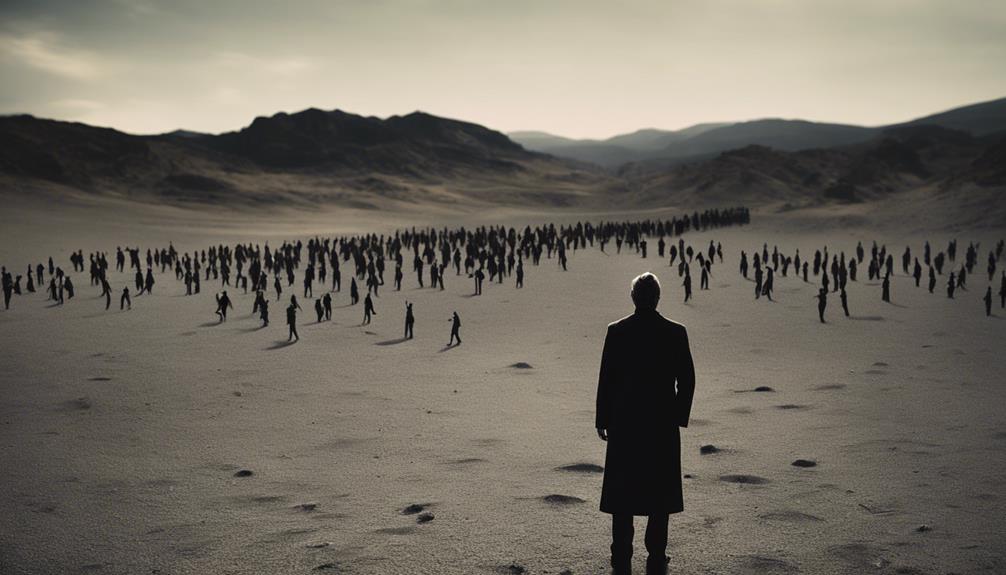Discover the captivating tale of 'The Scapegoat,' entwining ancient rituals of guilt transference with the complexities of mistaken identities. Explore the gripping contrast between John and Jean, revealing themes of duality and personal evolution. Uncover the symbolism behind the scapegoat, delving into the burden of carrying others' sins. Explore unexpected plot twists and profound moral dilemmas, challenging perceptions of human nature. The story intricately weaves together themes of atonement, forgiveness, and redemption, promising a journey of discovery into the depths of human psyche.
Historical Background of 'The Scapegoat'
The historical background of 'The Scapegoat' traces back to the rituals prescribed in the Old Scriptures book of Leviticus, particularly during the observance of Yom Kippur, the Day of Atonement. This sacred day holds immense significance in Judaism as a time for repentance and seeking forgiveness for sins.
The ritual described in Leviticus involves two goats, one chosen for sacrifice to atone for the sins of the people, while the other, the scapegoat, symbolically carries away the confessed sins into the wilderness.
The term 'scapegoat' itself stems from this practice, where one goat bears the burden of the transgressions of others, allowing them to escape punishment. The act of confessing sins over the scapegoat before releasing it serves as a powerful symbol of transferring guilt and seeking reconciliation with the divine.
Through this ritual, the concept of atonement and forgiveness is vividly portrayed, emphasizing the importance of acknowledging wrongdoing and aiming for spiritual renewal.
Character Analysis: John Vs. Jean
John and Jean's characters in 'The Scapegoat' present a fascinating contrast in their backgrounds and actions, shaping the narrative's exploration of duality and personal growth.
John, an English professor, inadvertently assumes Jean's identity, a French aristocrat, at a railway station, triggering a complex identity swap. John's encounter with Jean sets off a series of events challenging his self-perception and relationships.
In contrast, Jean's absence forces John to navigate unfamiliar territories, revealing hidden truths about himself.
Through the character analysis of John and Jean in 'The Scapegoat,' themes of duality, identity, and personal transformation are thoroughly investigated. John's journey as a scapegoat for Jean delves into the complexities of human nature, while Jean's mysterious absence acts as a catalyst for John's introspection and growth.
The interplay between these two characters highlights the intricacies of identity and the profound impact of assuming another's persona in the intricate web of relationships within the Scapegoat narrative.
Themes Explored in the Novel

Themes of identity, duality, and the darker aspects of human nature are intricately explored in 'The Scapegoat'. The novel delves into the consequences of assuming someone else's identity and the complexities of living a double life. Through the characters of John and Jean, it examines the psychological and emotional challenges of embodying another person.
Moreover, 'The Scapegoat' explores the idea of fate, coincidence, and the interconnectedness of individuals' lives. The book also delves into the complexities of relationships, family dynamics, and the impact of secrets and deception.
The weight of carrying someone else's sins as the Biblical Scapegoat can be overwhelming.
Discovering the blurred lines between one's true self and the persona created for survival can be unsettling.
Unraveling the hidden motivations and desires that drive human actions can be a chilling revelation.
Reflecting on the intricate web of connections that shape our lives can evoke a sense of awe and wonder.
Symbolism of the Scapegoat
When exploring the symbolism of the scapegoat, it's important to understand its representation of bearing the burdens of others. This concept, prevalent in various cultures and texts, signifies a transfer of blame or guilt onto an innocent figure.
Symbolic Sacrifice Meaning
Symbolic sacrifice through the scapegoat ritual embodies the act of bearing the sins or burdens of others. This profound symbolism carries deep emotional connotations, evoking feelings of empathy, catharsis, and communal responsibility.
- The scapegoat ritual conveys the weight of collective wrongdoing, offering a poignant reminder of the consequences of sin.
- The transfer of guilt onto the scapegoat serves as a powerful metaphor for the complexities of human relationships and the need for accountability.
- The act of scapegoating symbolizes the universal desire for redemption and the quest for spiritual purity.
- The ritualistic release of the scapegoat into the wilderness symbolizes the hope for renewal and the restoration of harmony within the community.
Through the symbolic sacrifice embodied in the scapegoat ritual, individuals are confronted with the enduring themes of forgiveness, justice, and the eternal quest for absolution.
Cultural Significance Analysis
To grasp the depth of the cultural significance behind the symbolism of the scapegoat, one must examine the historical contexts and societal implications intertwined with this ritualistic practice.
The scapegoat holds particular significance in the Day of Atonement, a sacred observance in the Jewish faith. This ritual involved the high priest symbolically transferring the sins of the community onto a goat, which was then banished into the wilderness, carrying away the burdens of guilt and transgression.
The act of scapegoating, whether in ancient religious ceremonies or contemporary society, serves as a powerful metaphor for the transfer of blame onto an innocent party. It reflects humanity's struggle with the concepts of atonement, forgiveness, and reconciliation.
Plot Twists and Intriguing Moments

Get ready for a rollercoaster ride of unexpected character revelations in 'The Scapegoat'. The plot twists will keep you on the edge of your seat, with moments that shock and intrigue at every turn.
Brace yourself for an enthralling experience filled with surprises you never saw coming.
Unexpected Character Revelations
The surprising character revelations in 'The Scapegoat' propel the plot forward with gripping twists and intriguing moments that keep readers on the edge of their seats. As you explore the intricate web of mistaken identities and complex role-playing, you find yourself captivated by the following emotionally charged elements:
- The heart-wrenching realization of betrayal that cuts deep into the soul.
- The adrenaline-pumping suspense of unmasking hidden motives and true intentions.
- The bittersweet empathy that tugs at your heartstrings as characters reveal their vulnerabilities.
- The shocking awe that leaves you questioning everything you thought you knew.
Each unexpected character revelation in 'The Scapegoat' adds layers of complexity to the narrative, challenging your perceptions and igniting a rollercoaster of emotions as you journey through the intricacies of assumed identities and their repercussions.
Twists That Shock
Prepare to be taken on a rollercoaster ride of unexpected events and mind-bending revelations as 'The Scapegoat' delivers plot twists that will leave you speechless.
One of the most shocking turns in the novel involves the revelation of a fallen angel among the characters. This surprising development adds a layer of complexity to the story, raising questions about morality, redemption, and the blurred lines between good and evil.
As the narrative unfolds, the fallen angel's presence introduces a dark and mysterious element that keeps readers on the edge of their seats. The sudden twist not only surprises but also challenges perceptions of the characters' motivations and the consequences of their actions.
'The Scapegoat' masterfully weaves together intricate plot twists that explore deep into the psychological and moral dilemmas faced by the characters. Each revelation builds upon the last, creating a web of intrigue that enthralls the reader until the very end.
Brace yourself for more surprising turns as you delve deeper into this enthralling tale.
Intrigue in Every Turn
Intrigue in Every Turn within 'The Scapegoat' is heightened by the continuous exploration of plot twists and gripping moments that leave readers spellbound. As you immerse yourself in the sin offering theme intertwined in the narrative, you'll encounter:
- The weight of guilt and redemption tugging at the protagonist's conscience.
- A sense of unease as the lines between truth and deception blur.
- Moments of intense vulnerability as the protagonist grapples with assuming another's identity.
- The chilling realization of the darker aspects of the self coming to light.
Each twist and turn in 'The Scapegoat' weaves a complex web that keeps you on the edge of your seat, captivated by Daphne Du Maurier's masterful storytelling. Prepare to be immersed in a world where every revelation adds layers to the intricate tapestry of this gripping tale.
Impact of 'The Scapegoat' on Literature
The novel 'The Scapegoat' by Daphne Du Maurier has left an indelible mark on the world of literature through its exploration of themes of doubling and mistaken identity.
The story of two goats, John and Jean, intertwined in a complex web of mistaken identities and psychological turmoil, has captivated readers with its gripping narrative.
Du Maurier's ability to investigate the darker aspects of the self through the parallel lives of the protagonists has influenced subsequent works that explore similar themes of duality and personal transformation.
The impact of 'The Scapegoat' on literature can be seen in the way it has inspired authors to probe deeper into the complexities of human nature and the consequences of assuming another's identity.
Through its exploration of doubling and mistaken identity, 'The Scapegoat' has cemented its place as a timeless classic that continues to resonate with readers seeking stories that challenge perceptions and investigate the depths of the human psyche.
Conclusion
As you reflect on the enthralling tale of 'The Scapegoat,' you can't help but wonder about the true identity of John and Jean.
The twists and turns of the plot keep you on the edge of your seat, yearning for more.
The symbolism of the scapegoat leaves you questioning its significance in your own life.
This novel's impact on literature is undeniable, leaving you eagerly anticipating the next story that will capture your imagination.



